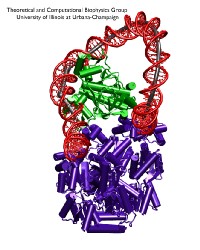Highlights of our Work
2024 | 2023 | 2022 | 2021 | 2020 | 2019 | 2018 | 2017 | 2016 | 2015 | 2014 | 2013 | 2012 | 2011 | 2010 | 2009 | 2008 | 2007 | 2006 | 2005 | 2004 | 2003 | 2002 | 2001

image size:
144.6KB
made with VMD
Bacteria must respond quickly to food sources in their environment. A common source of food for the bacterium E. coli is lactose; the bacterium's DNA contains genes for proteins needed for import and metabolic degradation of lactose and related sugar molecules. When lactose is lacking, a regulatory protein called lac repressor prevents the needless expression of lactose processing proteins; in doing so, lac repressor is assisted by a second protein, called catabolic activator protein (CAP). To understand the roles of the two proteins in regulating DNA, a recent report employed an advanced mathematical model for the flexibility of DNA and showed how lac repressor and CAP force DNA to form a loop such that the local genetic information cannot be expressed; the loop is held at its ends by the lac repressor and CAP inserts itself into the loop, adjusting and stabilizing it. Together, lac repressor and CAP form a genetic switch, in fact, the first such switch discovered long ago and explained now in detail through mathematics. When lactose appears around the bacterium, the lac repressor becomes deactivated by the molecule and looses its grip on the DNA. In this case the DNA loop opens and the CAP present assists in the expression of the genes needed for lactose processing.



